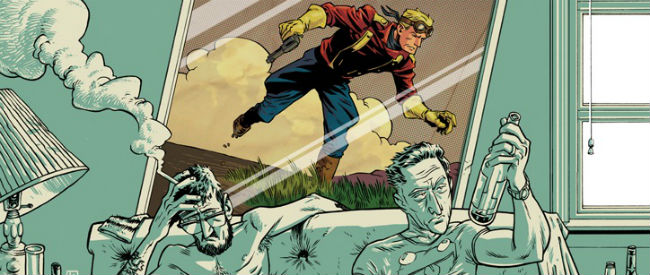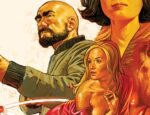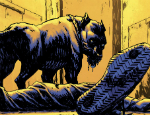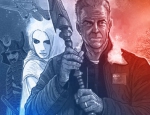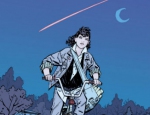Despite their best efforts, James Robinson and Greg Hinkle manage to bring back the public domain hero Airboy, in a scurrilous and invigorating metafictional take on the creative process.
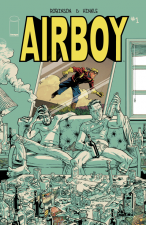 Back in the day it was pointy-hatted Prussian Otto von Bismarck who said, “Laws are like sausages, it is better not to see them being made”. More recently, quite a few pros who have been through the industry grinder would probably extend that to comics.
Back in the day it was pointy-hatted Prussian Otto von Bismarck who said, “Laws are like sausages, it is better not to see them being made”. More recently, quite a few pros who have been through the industry grinder would probably extend that to comics.
However, in Airboy #1, writer James Robinson and artist Greg Hinkle blow the bloody doors off the creative process, plunging their warts-and-all fictional avatars into a gonzo world of egomania and excess.
With style and scurrilous wit, Robinson and Hinkle take the reader on a subversive odyssey through the dark side of what might happen over the course of a “brainstorming” weekend in San Francisco.
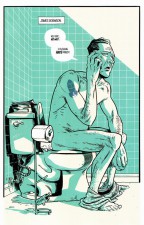 The issue kicks off with Image Comics head honcho Eric Stephenson trying to entice Robinson to revive Golden Age hero Airboy. The Robinson we meet is a jaded, cynical hack, feeling his best work is behind him and tiring of being the “40s guy”.
The issue kicks off with Image Comics head honcho Eric Stephenson trying to entice Robinson to revive Golden Age hero Airboy. The Robinson we meet is a jaded, cynical hack, feeling his best work is behind him and tiring of being the “40s guy”.
When Stephenson gives him the call (from his comically palacious office), it’s economic necessity rather than inspiration that entices the writer to take the gig.
However, it’s only when Hinkle arrives from LA for the weekend to work on the concept that the true depth of Robinson’s creative bankruptcy becomes clear. And when they hit the town in the hope that a few drinks might loosen the cogs, the louche Brit soon starts to lead his more straight-laced companion into temptation.
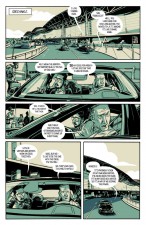 It becomes one of those nights when, as Eddie Campbell memorably wrote, “you uncork the bottle and the situations come tumbling out like circus acrobats”.
It becomes one of those nights when, as Eddie Campbell memorably wrote, “you uncork the bottle and the situations come tumbling out like circus acrobats”.
The book hums from first to last with energy and dark wit, in both Robinson’s dialogue and Hinkle’s bold, stylish art. The book also has a very individual colour palette that gives it a strong look while also going on to have a pay-off on the big reveal of the final page.
It’s obviously unclear how much the characterisation here correlates with the ‘real’ creators, but from page one, with Robinson bollock-naked on the loo, they’re both drawn in bold strokes.
The Robinson we meet here is a monstrous creation – an egotistical ogre, in thrall to his urges but putting on a front to hide his vulnerability, who drags Hinkle into his crepuscular demi-monde.
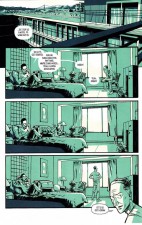 However, it’s not just a one-man show. Later on, Hinkle reveals an attribute that I’m sure will, ahem, pop up in conversation at a few convention bars over the next few months.
However, it’s not just a one-man show. Later on, Hinkle reveals an attribute that I’m sure will, ahem, pop up in conversation at a few convention bars over the next few months.
Airboy has obvious metafictional echoes of work like Charlie Kaufman’s screenplay for Adaptation, and the idea of actors playing a slightly skew-whiff version of themselves for comic effect is fairly familiar by now.
However, by embedding the device so neatly into the world and form of comics, Robinson and Hinkle create something refreshing and exciting, with a lot of grown-up polish.
For all its acts of random stupidity and apparently self-destructive urges, it’s nice to see the comics world take an imaginative and comical sideways look at itself. The ‘surprise’ at the end of the issue indicates that we might be heading down a path that’s been trodden before, but the strength of this opener – one of the most entertaining comics I’ve read so far this year – indicates that there’s much more to come.
James Robinson (W), Greg Hinkle (A) • Image Comics, $3.50, June 3, 2015





